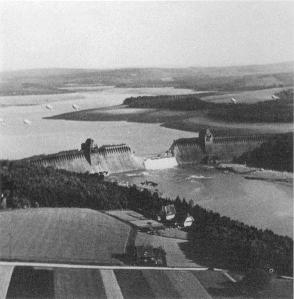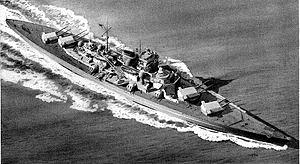On the evening of 16 May 1943 nineteen Lancaster bombers of the specially-formed 617 Squadron, Royal Air Force, took off from RAF Scampton in Lincolnshire. The operation was codenamed Chastise. Its targets were the Mohne, Eder and Sorpe dams in Germany’s Ruhrgebiet, providing hydro-electric power for the Third Reich’s armaments industry. The dams were very well-defended and could only be breached with massive bombs – bigger than any RAF plane could carry – or by torpedoes fired directly at them below the water. For this reason the Germans had installed multiple torpedo nets in front of all the dams, making placing a big enough charge in the right place impossible. Or so they thought… At the time the average bombing error was five miles. But this was to be a precision attack..
Enter the nutty professor … well, Barnes Wallis, the marine- and aero-engineer who had designed the Wellington bomber and the R100 airship with their revolutionary geodetic frames, exploiting the immanent strength of the triangle. Wallis (1887-1979) had left school at 17 to start an apprenticeship at Thames Engineering Works at Blackheath, but later transferred to J Samuel White‘s boatbuilders at Cowes in the Isle of Wight. In 1913 he left J Samuel White’s when an opportunity arose for him to work on airship design – a logical enough move – and then aircraft design at Vicker’s.
Early in 1942, Wallis began experimenting with skipping marbles over water tanks in his garden at home, leading to his April 1942 paper “Spherical Bomb — Surface Torpedo”. Except these would not be stones, but four-tonne bombs, shaped like oil drums (not spherical, as in the 1955 film – the design was still top secret when the film was made!). They had to be dropped from a very precise height – 50 feet (18 metres)(!), which was beyond the capabilities of altimeters. While the RAF were pondering the solution, one of the 617 Squadron officers went for a night out in the West End to see a show and saw spotlights intersecting on the stage. Bingo! When two angled lights on the Lancaster’s belly formed a figure of eight on the surface of the water, the aircraft was spot-on. Then, the bombs would spin anti-clockwise, to the direction of travel, which would ensure they bounced correctly, over the torpedo nets, and also push them against the dam when they touched it and descended. At nine metres depth, they would detonate. What they started, the pressure of millions of tonnes of water would finish.
It was a triumph of creative imagination and ingenuity, although only two of the dams were actually breached. But the casualties among the bomber crews were very heavy, and Wallis was devastated. The damage to German war industry was not as great as hoped, but it was portrayed as a timely triumph at a time when war-weariness was at its most intense. An air reconnaissance photograph was emblazoned all over the front of the Daily Telegraph on the morning of 18 May, showing water pouring through the breach in the Mohne dam. How many times have you seen an air reconnaissance photograph on a newspaper front page? One wonders who authorised such an irregular press release. Could it have been someone who was a former journalist? Like Churchill…

The Mohne dam in the aftermath of Operation Chastise.
As an élite precision attack force, 617 Squadron was used for special missions. After the Dambusters mission, it began to attract ridicule as ‘The Squadron with one op’. Barnes Wallis, however, came up with another revolutionary bomb, the 5.443 tonne (12,000 pound) Tallboy. The bomb was extremely aerodynamic, designed to be dropped from 18,000 feet (5,500 metres). That meant it hit the ground at 750 mph (1200 kph), which created a crater 30 metres wide and 24 metres deep. The idea was to produce an ‘earthquake’ effect so that if the target, such as a concrete bunker, was not itself smashed to pieces, it would just fall into the great big hole.
The Tallboy entered service on 8 June 1944 and was first used against the Saumur rail tunnel that night. The line was destroyed — one Tallboy drilled through the hillside and exploded in the tunnel about 18 metres below, completely blocking it. They were subsequently used against V-1 cruise and V-2 ballistic missile launch sites and facilities, and the V-3 supergun.
But Wallis’s background as a marine engineer resurfaced in September that year. Major surface combatants remained lethal adversaries, even though they were obsolescent in the face of submarine and air power. Throughout the war the German battleship the Tirpitz had evaded British attempts to destroy it, skulking in north Norwegian fjords. At 42,900 tonnes, she had been sister ship to the Bismarck. She remained a potential threat to the convoys supplying Russia, although by 1944 those were not as crucial as they had been. On 15 September1944 the ‘Dambusters’ Squadron launched Operation Paravane, attacking the monster from airfields in northern Russia under a special agreement with the Russian Allies, who obviously had an interest. At the time she was moored in the Kåfjord (Kaa fjord), south-west of the Altenfjord (Altafjord), at 69o 56’ 22” N, 23o 03’ 42” E. The Kåfjord was out of range of bases in Britain. Although Tirpitz was not sunk, she was crippled sufficiently to prevent her ever posing a threat again.
Prior to the actual raid, some 38 Lancaster bombers took off from RAF Lossiemouth in Scotland. Most were 617 Squadron but some were from 9 Squadron. One turned back and, after an eleven hour flight, the other 37 tried to land at Yagodnik airfield (64o 22 N, 40o 42 E) in north Russia, on the Northern Dvina river, close to Arkhangel’sk, which was designated as a temporary RAF base. Yagodnik was just 600 miles from the target. The base was drenched by heavy rain and thirteen of the British aircraft could not find the airfield and landed at various remote places across north Russia. Colonel Loginov, Chief of Staff of the White Sea flotilla, made determined efforts to find the aircraft and recover their crews, including one crew who were guided on foot to a lake where a sea-plane could pick them up and take them to the Yagodnik base. Two of 617’s aircraft and four of 9 Squadron could not be retrieved from the marshes where they had landed, but seven were recovered, plus, very importantly, all the crews. Without Loginov’s heroic efforts and those of his boss, Maj.-Gen. Dzymba, Chief of the White Sea Flotilla Naval Air Forces, the attack on the Tirpitz would have been much weaker. As a result the RAF later recommended Loginov, Dzymba and Vice-Admiral ‘Pantaleyev’ (Panteleyev), the Commander-in-Chief of the White Sea flotilla, for British honours. Panteleyev, as a Vice-Admiral, got the Companion of the Bath (CB), while Dzymba and Loginov were made Commanders of the British Empire (CBE).

The German battleship Tirpitz at sea

The Altenfjord
In the Kåfjord, surrounded by mountains and anti-aircraft batteries, Tirpitz was exceptionally well defended. There were also enough smoke diespensers to fill the fjord with a veil of smoke in just eight seconds. But One 12,000 lb Tallboy struck the ship 50 feet aft of her prow, pierced the bow compartments without detonating and came out under the waterline on the starboard side before exploding. This underwater explosion very close to her hull, plus those from other Tallboys exploding nearby did severe damage to her machinery and engines.
Though she remained floating, the Tirpitz was immobile and could only be repaired in a big dry dock, and it would be impossible to get her to one in Germany in the face of British naval and air superiority.
A German report recovered by the Allies after the war stated the Kriegsmarine’s conclusion: “It was eventually decided at a conference on 23 September 1944 at which the C-in-C – Admiral Dönitz – and Naval Staff were present, that it was no longer possible to make Tirpitz ready for sea and action again…” They tried to move her south to use as a floating battery for the defence of Tromso, but did not realise that this would bring her in range of bombers based in Scotland. The British did not know how badly they had damaged her and launched two more attacks. The first, Operation Obviate, inflicted no further major damage. But on 12 November 1944 the RAF launched a final attack, this time again beginning with a ‘C’, Operation Catechism. In a joint attack by 617 and IX Squadrons the Tallboy bombs hit her magazine, and she capsized with the loss of most of her crew.
Although Barnes Wallis is best known as an aero-engineer, who went on to develop the swing-wing concept used on the F-111 and Tornado, he began his long and creative career as a marine engineer. There was a certain irony in the use of his earthquake bombs to finish the Tirpitz. Like the underwater monster, the kraken, they wrested the great battleship from below, and pulled her beneath the deep…
Chris Bellamy



